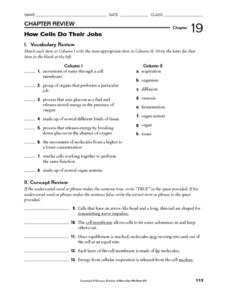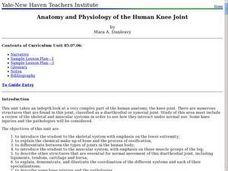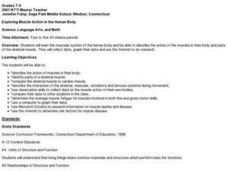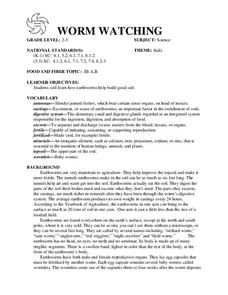Curated OER
Body Voyager
Students explore the significance of a resting and an active heart rate. In this heart instructional activity students chart data on their pulse and draw a diagram of the heart.
Curated OER
What Becomes of Cell?
Sixth graders analyze and compare a cell's tissues, organs and organ systems. They watch a video reviewing the body systems and design poster boards showing their functions.
Curated OER
Science Jeopardy
Wow! Review an entire semester of biology curriculum playing this Science Jeopardy game! The variety of topics is extremely broad, so you will need to review each question to find if they all apply to your course. As you find material...
Curated OER
How Cells Do Their Jobs
In this cells worksheet, high schoolers will review cell characteristics and structure and different types of cells and what role they play in the body. Students will investigate experimental results of the influence of sucrose on the...
Curated OER
Anatomy and Physiology of the Human Knee Joint
Learners examine human anatomy with a focus on the knee joint. In groups, they research the chemical makeup of human bones and explain the different types of joints found in the body. To end the lesson plan, they identify the other...
Curated OER
Plant Structure and Growth
This plant structure and function PowerPoint addresses the main organs and the factors that affect its development as well as going into detail about the specializations at a cellular level. The cell functions and system...
Curated OER
Exploring Muscle Action in the Human Body
Students collect and graph data and use the internet to research the skeletal muscles.
Common Sense Press
What is the Skeletal System?
Young scholars investigate the human skeletal system. In this biology lesson, students trace the outline of their body onto butcher paper and fill in the names of the bones. Young scholars use an overhead transparency of the human...
Curated OER
The Skeletal System
Students identify bones off a skeleton during quizzes; assemble disarticulated skeletons; bird, frog and rat. They dissect frogs, remove the muscle tissue, and identify of bones.
Curated OER
WORM WATCHING
Learners investigate how earthworms help build good soil. They examine the worms carefully to find the ringlike segments and swollen band at the front of the earthworm's body. Students take turns dampening the soil every day and adding...
Curated OER
Human Body Digestion
In this health worksheet, students find the words that related to the concept of digestion. The answers are found at the bottom of the page.
Curated OER
The Inside Story- Cells, Organs, and Systems of the Human Body
Fourth graders study the human body from cell level to the inter-relationships of the systems in this unit. Students practice study skills throughout the unit.
Curated OER
All's Well for Stem Cells
By exploring the latest research on cell and tissue renewal your young scientists can understand the various internal body parts and systems examined in these studies.
Curated OER
Digestive System, a Kinesthetic Lesson
Learners actively act out an aspect of the digestive tract on two parallel strips of tape on the floor 3-4 feet apart and width of classroom which represent the digestive tract.
Curated OER
What's Inside
Students become more familiar with life science in the context of the scientific method which helps them to become familiar with the various kinds of life science diagrams they may see on a GED science test.
Lake Science Collaborative
Blood Circulation Simulation
Act out the circulation of blood in the body with an innovative activity. Kids act as either body parts or blood, and carry necessary nutrients and waste throughout different stations to represent the way that oxygen circulates.
K12 Reader
Xylem and Phloem
The vascular tissue found in plants is the subject of a two-part comprehension learning exercise that asks kids to read the provided article and then to respond to a series of comprehension questions.
Curated OER
Structure and Function of the Cell/Introduction to the Cell
So, this is not technically a worksheet, but rather a chapter of reading material, pictures, and diagrams introducing young biologists to the cell. Cell theory, diversity, size, and shape are described. The internal organization and...
Curated OER
What's on Your Plate?
Students demonstrate the path of food in the body. In this biology activity, students conduct an experiment to determine how large the the digestive system is. They name the different organs involved in the digestive process.
Curated OER
Gregory Carter
Young scholars explore how the immune system, fights a war with a pathogenic organism: one of the many bacteria, viruses, and protozoans that can infect our bodies and cause disease.
Curated OER
Experiment to Mimic the Digestive System
Students demonstrate how digestion occurs. In this biology lesson, students compare the mass of sandwiches before and after addition of HCl. They collect data and formulate conclusion based on experimental results.
Curated OER
Breaking News English: Fleas Have Organ-Saving Antifreeze
In this English worksheet, learners read "Fleas Have Organ-Saving Antifreeze," and then respond to 47 fill in the blank, 7 short answer, 20 matching, and 8 true or false questions about the selection.
Curated OER
Pump It Up!
Young scholars design a pumping device that will effectively pump fluid through a model "cardiovascular system." They explore the effects of too much and too little pressure on a circulatory system.
Pleasant Valley Community School District
Integumentary System
This document can be used as a slide show to introduce your human body systems class to the integumentary system, also know as skin. Topics outlined include the roles of skin, details about its its layers, and color (cause and...























